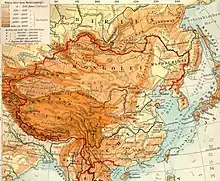Mongolian Plateau
The Mongolian Plateau is the part of the Central Asian Plateau lying between 37°46′-53°08′N and 87°40′-122°15′E and having an area of approximately 3,200,000 square kilometres (1,200,000 sq mi). It is bounded by the Greater Hinggan Mountains in the east, the Yin Mountains to the south, the Altai Mountains to the west, and the Sayan and Khentii mountains to the north.[1] The plateau includes the Gobi Desert as well as dry steppe regions. It has an elevation of roughly 1,000 to 1,500 meters, with the lowest point in Hulunbuir and the highest point in Altai.[1]

| Mongolian Plateau | |||||||
|---|---|---|---|---|---|---|---|
| Traditional Chinese | 蒙古高原 | ||||||
| Simplified Chinese | 蒙古高原 | ||||||
| |||||||
Politically, the plateau is divided between Mongolia, China and Russia. In China, parts of the Inner Mongolia and Xinjiang autonomous regions lie on the plateau. In Russia, the plateau forms part of Buryatia and the southern Irkutsk Oblast.
History
The plateau was inhabited and conquered by various groups, including (chronologically) the Xiongnu, Xianbei, Göktürks, Tang dynasty, Liao dynasty, Mongol Empire, Yuan dynasty, Northern Yuan dynasty, and Qing dynasty.
Changing environment
Many lakes on the Mongolian Plateau such as Qagaan Nurr and XinKai Lake, have shrunk by two-thirds of their surface area. Some have dried up completely; the Huangqihai Lake and Naiman Xihu dried up entirely between 1980 and 2010. While a few lakes such as East Juyan Lake and Had Paozi have grown, on average the total surface area of lakes has shrunk by 30%.[2][3]
References
- Zhang, Xueyan; Hu, Yunfeng; Zhuang, Dafang; Qi, Yongqing; Ma, Xin (2009). "NDVI spatial pattern and its differentiation on the Mongolian Plateau". Journal of Geographical Sciences. Springer-Verlag. 19 (4): 405. doi:10.1007/s11442-009-0403-7.
- "Shrinking Lakes on the Mongolian Plateau". NASA. 8 April 2015. Retrieved 26 November 2016.
- Tao, Shengli; Fang, Jingyun; Zhao, Xia; Zhao, Shuqing; Shen, Haihua; Hu, Huifeng; Tang, Zhiyao; Wang, Zhiheng; Guo, Qinghua (17 February 2015). "Rapid loss of lakes on the Mongolian Plateau". Proceedings of the National Academy of Sciences. 112 (7): 2281–2286. doi:10.1073/pnas.1411748112. PMC 4343146. PMID 25646423.
External links
- John, Ranjeet; et al. (2013). "Vegetation response to extreme climate events on the Mongolian Plateau from 2000 to 2010". Environmental Research Letters. IOP Publishing. 8 (3): 035033. doi:10.1088/1748-9326/8/3/035033.
- "Mongolian Plateau region, Mongolia and China". Britannica.com. Encyclopædia Britannica. 2 August 1999. Retrieved 26 November 2016.